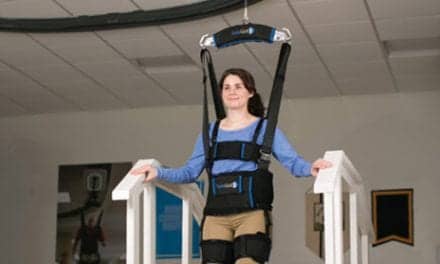CAPTION: Lucille is pictured on equipment fitting day, receiving her new power wheelchair.
Power wheelchair seat functions can greatly increase client independence, as demonstrated through this case study of a nonagenarian.
by Kirsten Davin, OTD, OTR/L, ATP, SMS
Lucille is a 92-year-old female client who presents with significant limitations in functional mobility and the performance of activities of daily living due to progressive, generalized weakness and debility. Lucille is a widow who lives independently in the home she shared with her husband of 75 years. She has four children and many grandchildren who live nearby and routinely assist with tasks as needed. Lucille farmed with her husband for their entire marriage and continues to be involved in her son’s farming operations. She values cooking meals for her family, venturing outdoors to observe the farm operations, visiting with her family who frequent her home, caring for her dog, and performing housekeeping duties as able. As of late, Lucille’s daily tasks have been quite limited due to multiple medical diagnoses, some of which had recently been progressive in nature. Hence, the need for a power wheelchair with seating functions to aid her in addressing these new issues.
She presented to the seating evaluation with a history of diabetes, a stage 2 pressure injury to the right ischial tuberosity, congestive heart failure, and chronic pain. Her chronic pain was caused in part by a significant osteoarthritis presence, including a history of bilateral total knee replacements and a recent history of a right total shoulder replacement, with concurrent range of motion limitations. Frequent repositioning in the chair, recliner, or bed is commonplace for Lucille due to this chronic osteoarthritis pain.
Lucille also presented with macular degeneration, for which she required use of an optical character reader to perform daily tasks such as medication, most notably insulin management. She also relied on the optical character reader to read her mail or recipes, pay bills, and review the headlines in the daily newspaper. Fortunately, Lucille was able to see large shapes and structures within the room, and her vision was more greatly intact peripherally, as is often the case with macular degeneration. This granted her the ability to safely drive the power wheelchair within both common and unique environments.
Upon review of her functional performance, it was noted that Lucille was not able to perform functional mobility within her home and was only able to ambulate approximately five steps with a wheeled walker prior to acquiring a power wheelchair.
Lucille was issued a front-wheel-drive power wheelchair, complete with power adjustable seat height, power tilt and recline, and power elevating leg rests. She demonstrated excellent skill in driving the power wheelchair, despite her vision limitations from macular degeneration.
Power Adjustable Seat Height
The power adjustable seat height feature, commonly referred to as a power seat elevator, provides the client with the ability to raise the entire seating system by raising the seat to floor height of the chair while maintaining the same seat-to-back angulation and without altering other aspects of the seating system. This feature often benefits wheelchair users in the performance of transfers from the chair by raising the seat to floor height, making the process of transitioning from sitting to standing easier for those who present with generalized weakness or debility.
Lucille experienced vast improvement in her level of independence via the utilization of the power adjustable seat height feature. It allowed her to once again independently transfer to and from the wheelchair to multiple surface heights, access her refrigerator, perform meal preparation on her kitchen counter, complete a load of laundry, and perhaps most importantly, in Lucille’s opinion, look out the kitchen window to see how her son and grandson were doing as they worked on farm machinery directly behind the house.
Power Elevating and Articulating Leg Rests
When considering a powered mobility base, it is imperative to consider the implementation of power elevating and articulating leg rests. This leg rest design allows the client to adjust the angle between the seat and the lower leg support to allow knee flexion or extension as needed. The term “articulation,” when used in the context of power wheelchair seat functions, refers to the design of the leg rest, which lengthens during the performance of knee extension.
In Lucille’s case, she required power elevating leg rests as she was unable to independently manage manual leg rests, nor was she able to acquire a fully reclined position without use of the power elevating leg rest option. Elevating leg rests also afforded her the opportunity to address the presence of frequent lower extremity edema and fluid retention, a symptom of congestive heart failure, as well as allow her to reposition within the wheelchair, to accommodate for the presence of chronic pain and limited lower extremity active range of motion.
Power Tilt
Two types of power tilt options, anterior and posterior, are available on many seating systems. Power tilt maintains the existing seat to back angle, while tilting the entire seating system either anteriorly or posteriorly. The posterior tilt feature offers the user the ability to tilt the entire seating system up to 60 degrees, posteriorly, offering the ability to reposition with the assist of gravity and offset pressure from the seat’s contact surface.
The anterior tilt option offers up to 15 degrees of anterior tilt, depending on the model of the selected wheelchair. Anterior tilt can provide exceptional benefits to wheelchair users both functionally and physiologically. For some, just a small change in orientation anteriorly can aid in tone management and maintenance of abnormal reflexes, which can often interfere with function. Anterior tilt can also aid in providing safe and effective transfers out of the wheelchair, especially for clients with lower extremity weakness.
Lucille required both posterior and anterior tilt. Each was utilized with transfers into and out of the wheelchair. When transferring into the wheelchair, Lucille would engage the posterior tilt option to tilt herself back approximately 45 degrees, which would allow her to then use her arms to reposition herself fully back in the wheelchair seat and properly on the wheelchair cushion. The posterior tilt option also afforded her added protection against the recurrence of pressure injuries via the ability to perform weight shifts independently and effectively, removing pressure from the contact area when in a seated position.
When exiting the wheelchair, Lucille required the anterior tilt feature, used in conjunction with the seat elevator to not only raise the height of the seating system, but to also tilt her anteriorly to allow her to bear weight more easily on her feet and acquire a standing position for transfers.
Power Recline
The power recline feature performs similarly to a common recliner that may be found in many homes. When integrated into a power wheelchair, the power recline feature allows the seat to back angle to adjust to the client’s desired comfort level, often extending to nearly 165 degrees of extension. Power recline offers the wheelchair user the ability to adjust the seat to back angle on the chair, thus offering accommodation for clients who present with chronic pain, such as Lucille, to reposition as frequently as needed. This feature is also helpful for clients who require assistance with repositioning. When paired with a tilt system, the power recline combination allows wheelchair users the ability to perform gravity-assisted repositioning and greatly increase their level of independence within the wheelchair.
Drive Wheel Considerations
One of the first considerations to be made when selecting a power wheelchair involves the placement of the drive wheels. For clients who will be primarily using their power chair within the home, a central-wheel drive power chair is typically recommended in order to provide as small of a turning radius as possible. Although the center or mid-wheel drive chair offers the smallest overall turning radius, sometimes individuals prefer the rear-wheel drive option for its improved stability and ease of control.
Clients who intend to be active outdoors or over rough terrain while using their wheelchair, such as those who enjoy visiting parks and observing outdoor sports, may benefit from a front-wheel drive option, as the large drive wheels on the front of the base will better accommodate for and manage the rough terrain that may accompany outdoor activities.
Due to her desire to be outdoors, observing her son’s farm operation, visiting with her children and grandchildren who live next door, and enjoying the outdoors as she had for years with her husband, a front-wheel-drive chair was selected for Lucille.
Return to Independence
In Lucille’s case, the provision of a front-wheel-drive power wheelchair base offered her the opportunity to return to the activities she loved prior to the onset of generalized weakness and debility. Additionally, power seat functions provided the opportunity to regain independence and perform the activities of daily living she valued.
If paired with an appropriate base, power seat functions can often be combined and used collectively, not only to offer improved mobility and function, but also to protect the user via the assurance of improved safety with transfers and the provision of adequate pressure relief. RM
Kirsten Davin, OTD, OTR/L, ATP, SMS, an occupational therapist of nearly 20 years and expert in the seating/positioning industry, currently serves as a clinical assistant professor and academic fieldwork coordinator for Baylor University’s OT Doctorate Program. For more information, contact [email protected].
What’s In a Cushion?
A look at the common support surface materials for wheelchairs.
by Caitlin Boland, PT, DPT, NCS, CBIS
By better understanding the types of available wheelchair cushions, medical providers including physical and occupational therapists can help protect end users from negative effects.
Common seating goals for end users include, but are not limited to: comfort, pressure distribution and management, positioning, function, comfort, stability, heat and moisture dissipation, and vibration dampening.1,2 Understanding these goals is of paramount importance with regard to selection of the appropriate seat back and cushion material. Below is a look at common support surface materials and functions.
Foam1: Foam is classified as open-cell or closed-cell. Open-cell foams allow airflow between membranes, which allow for greater ventilation, while closed-cell foams have internal structures that are encapsulated in a membrane, making them denser with less airflow. Open-cell foams do tend to absorb fluid, making them more difficult with regard to maintenance of hygiene. Viscoelastic foam and matrix have higher viscosity and are slow to return to their original non-compressed state; they also present with good envelopment and improved thermal qualities as compared to polyurethane or latex foams. Foam cushions and back supports can be made available in both flat and contoured designs. It is important to note that when a foam is too soft, this can result in rapid “bottoming out” of a cushion, resulting in increased pressure, specifically through bony prominences, and thus increased risk of an end user for skin breakdown.
Elastomer2: An elastomer is a polymer shaped into a “honeycomb.” The honeycomb responds similarly to foam when a user sits on it. Similar to foam, the honeycomb can be contoured by the cushion manufacturer. Cushions comprised of this material are typically lightweight and easy to clean.
Fluid1-2: Fluid works by moving within its container to come to a constant, equal pressure over the entire surface. Manufacturers often use segmentation in the design of the fluid packs to control the flow of the fluid. Segmentation also reduces the surface tension of the fluid pack to allow for immersion. Fluid provides better skin temperature control than other materials by conducting heat away from the skin. Of consideration, some fluids may freeze if left in a particularly cold environment; for this reason, extreme temperatures should be avoided. Fluid also offers skin protection through its ability to adjust to body movements. This adjustment reduces the shearing forces that would otherwise be present through horizontal shearing forces on the cushion. Intermittent kneading or massaging of fluid is required to ensure proper functioning. It should also be noted that fluid-filled cushions are often heavier than cushions comprised of other materials.
Gel1: Gel is a semi-solid material made of silicone, polyvinyl chloride. Gel does not allow sufficient displacement of the material for an end user to fully immerse into the material. It has been found to be effective in preventing shear and can be easy to clean, but like fluid-filled support surfaces, gel support surfaces can be heavy and difficult to repair. Gel surfaces do lack airflow for moisture control and can increase skin temperature after prolonged positioning.
Air1: Air-filled support surfaces are made of sealed compartment membranes that hold air. Air-filled support surfaces can be comprised of a singular chamber or may be divided into multiple compartments to allow for airflow. These types of cushions allow for pressure to move from high to low pressure areas. Air-filled cushions allow for immersion of the end user into the surface. Initial adjustments of inflation pressure are important to establish proper immersion of the body into the cushion. Air-filled support surfaces are lighter in weight than most other support surfaces. They can, however, be more difficult to maintain or repair and are more at risk for puncture or tear. Air-filled support surfaces are often more unstable, which can negatively affect an end-user’s balance, stability, and function. RM
Caitlin Boland, PT, DPT, NCS, CBIS, is a Level III Inpatient Physical Therapist for Gaylord Specialty Healthcare, Wallingford, Conn.
References
- Consortium for Spinal Cord Medicine Clinical Practice Guidelines. (2000). Pressure Ulcer Prevention and Treatment Following Spinal Cord Injury: A Clinical Practice Guideline for Health-Care Professionals. Paralyzed Veterans of America.
- Sherman S. (2011, November). Skin Protection and Cushion Materials. Retrieved from: http://www.sunrisemedical.ca/dealer-clinician-tools/education-in-motion/clinical-corner/november-2011/skin-protection-and-cushion-materials. Accessed January 1, 2021.





